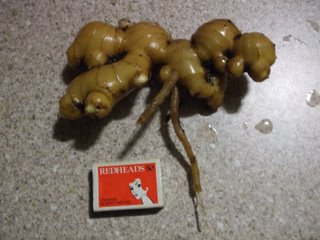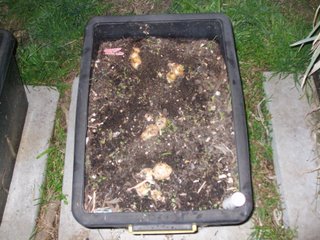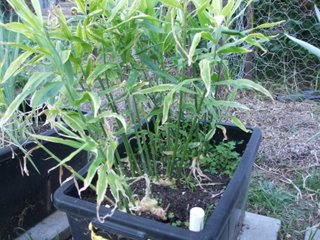We like to cook Asian food of various sorts and nationalities and in the process we use quite a lot of ginger, so in the spirit of sustainability and reducing food-miles, I wanted to grow some. I have tried on several occasions both in containers and in the ground, but the result always seemed to be the same: one nice green shoot was produced and then the plant promptly died. In a fit of pique I decided to follow the old adage “if all else fails, read the instructions” and looked it up in my gardening books.
Ginger (Zingiber Officionale) is a tropical plant from the same family as turmeric (Curcuma Longa) and galangal (Alpinia Galanga)and my initial fear was that I could not provide the correct environment for it to grow in, however after some study I found that the most likely cause of my problems was lack of drainage. According to the books, ginger does best in a well drained sandy soil with lots of organic matter because it is a heavy feeder. My problem had been the good old Sydney clay.
I decided to plant some in my main veggie patch where there was some clear space near the cucumbers that I had growing. Fresh ginger rhizomes start to send out white spikes in summer if not used quickly so I broke of four thumb-sized pieces which had at least one shoot each from our current supermarket-bought stock. I planted these into the cucumber bed about 25mm down and about 500mm away from each other. I planted them in November but in September the bed had been deeply dug and a considerable amount of horse, cow and chook poo added. A newspaper and lucerne hay mulch was then laid down on top of the bed. At the stage when the ginger was planted the cucumbers were yielding well and planting the ginger had no effect on that.
The ginger initially sent up one green shoot for each plant that were 25 to 50 centimetres high. As the summer progressed more shoots were sent up to the point where the rhizomes appeared to be 20 to 25 centimetres long. The books specify regular feeding, but the initial preparation must have been enough because apart from regular watering every three days or so, no other management was required. Certainly none of the other pests or diseases that occasionally assail my veggies showed the slightest interest in the ginger.
Again, the books state that ginger should be harvested in the late summer for fresh use or left until the leaves have died off in the late autumn if harvested for drying. I left my harvesting until the leaves were dying off and found the ginger was still OK for fresh use. The harvest was four large, unblemished rhizomes and the one I used immediately had excellent flavour, after which I had about a kilo or more of fresh ginger to store somehow. I left the two roots outside in the shade for a week to harden off the skin a bit (that was the theory anyway) and then had to work out a way to preserve them.
I wanted to use them as fresh ginger, as opposed to dried, pickled, candied or otherwise preserved ginger so I put some moist coarse river sand into a recycled broccoli box and put the box in the garage. This successfully kept the ginger in good condition throughout the winter. By late spring the remaining ginger had some serious sprouts and was a little dried out in parts although the flavour was still good. I was able to remove some of the sprouting rhizome and plant it inot the veggie patch where they did quite well.
I suppose the moral of the story is to be prepared to give growing anything a go and, when all else fails – read the instructions!
Update

This all happened some years ago and since then I have had variable response, but I believe that I have now hit upon the winning formula for growing ginger. Make yourself a self watering growing container – see the article in the Container Growing area of the site – and then plant some sprouted ginger into that. The continually moist, rich, friable soil works a treat but there is one more little trick. I think that even though it is tropical, ginger probably grows on the jungle floor and has the protection of taller vegetation, the Sydney sun certainly seems to burn the living daylights out of it. To get around this I made a loop of wire at each end of the self watering container and stretched some sarlon shade cloth over them to form a cover, breaking down the effect of the sun a bit. The effect of the shade and the water was a bumper crop of ginger, so give it a go! 



